Creative Capital: Learn the art of glassblowing with this Singapore glass artist
Advertisement
Women
Creative Upper-case letter: Acquire the art of glassblowing with this Singapore glass artist
Inspired by Netflix'southward Blown Away to have up glassblowing? Look for Barbara Jane Cowie, a Sydney-born, Singapore-based glass artist, whose works can be seen at Changi Drome and Ocean Financial Centre.
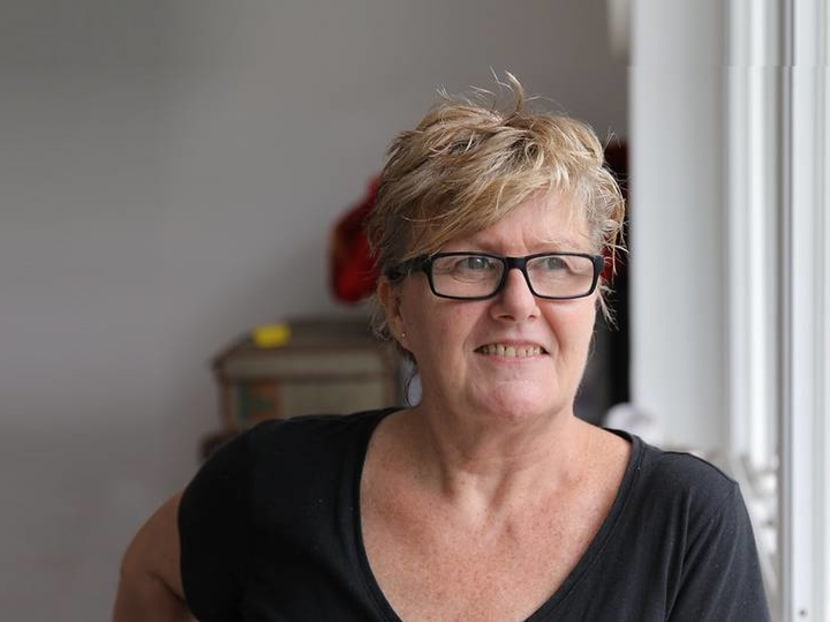
Glass artist and educator Barbara Jane Cowie. (Photo: Art Glass Solutions)
04 Apr 2022 06:14AM (Updated: 04 Jul 2022 08:43PM)
I am, like many of you, I suspect, a bit of a Netflix junkie. Ane of my favourite contempo series is Blown Away, whose second season dropped in January.
The art of glassblowing looks incredible. The results, when done well, can be magical. Simply glassblowing – or working with hot glass, in general – also looks dangerous, exhausting and nerve-racking.
In Singapore, you take Barbara Jane Cowie, a respected Australian professional glass artist and instructor, who moved here to teach. That was xviii years agone. Given the popularity of Diddled Away, I idea I would check in with her.
WHAT DREW YOU TO Glass ORIGINALLY?
I was first introduced to glass at the Sydney Higher of the Arts in the early 1980s. Drinking glass was then a newly introduced fine art material and a new expanse of creative practice in Australia. I majored in glass and sculpture, and graduated with a degree in 1983.
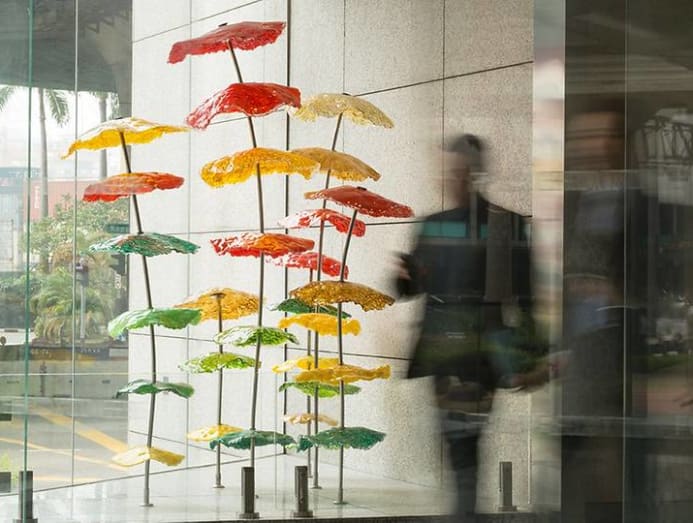
In my early 20s, I travelled to England and Europe. It was there that I saw hot glass for the first time and I immediately fell in love with this molten fabric. Drinking glass has a beauty and intensity like no other cloth. Symbolic of the fragility and beauty of life, it offers colour, texture, light and flowing course. Mesmerised by the glowing liquid and fascinated past how glass tin be formed, I knew instantly I wanted to be a glassmaker for the rest of my life.
Yous ALSO HAVE A Principal'South Caste FROM THE Academy OF S AUSTRALIA. WHAT OTHER EXPERIENCES DO Y'all HAVE?
I spent two of the four years abroad working with various glass artists and in different glassmaking studios in Europe and England. Hours were spent watching the glassmakers to learn about how the drinking glass is formed. I returned to Australia via Russia, Japan and Indonesia in the tardily 1980s.
While in England, I heard about a glassmaking training centre in the JamFactory, a craft and design centre in Adelaide. Adamant to learn more and develop my ain practice as an artist and glassmaker, I moved in that location in 1989 to work as a trainee.
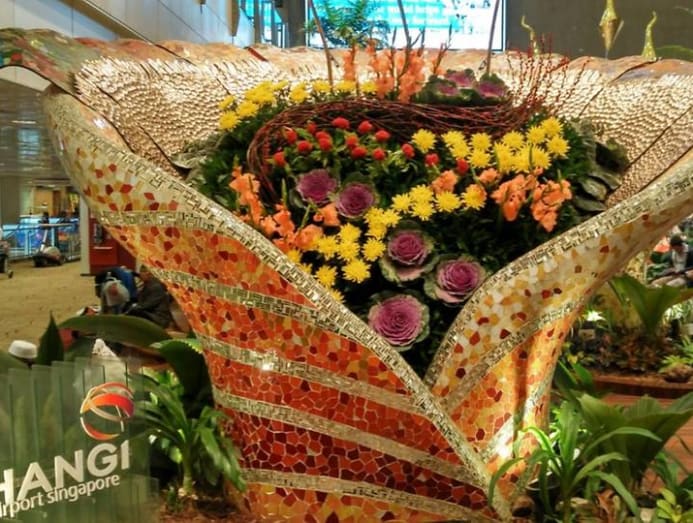
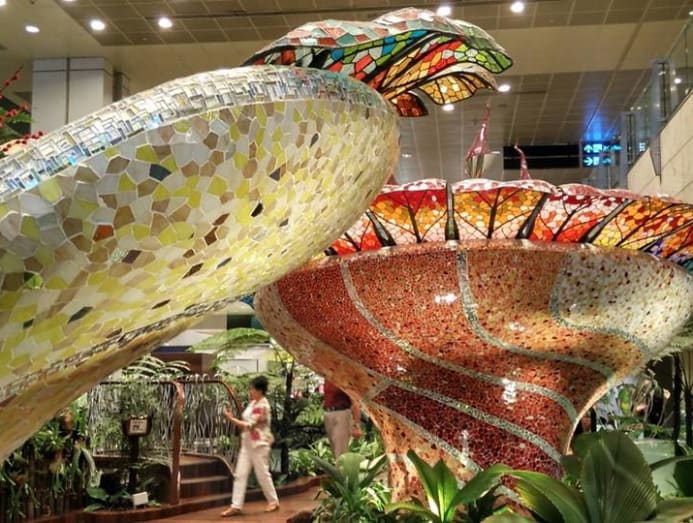
I was also curious to learn more than about Japan. I knew at that place were many glassmaking studios there, so in 1991, I prepare off to piece of work at the Fujigawa Craft Park for a few months. I also worked in a product glass factory in Yamanashi Ken, and at the Unga Kogakan Glass Studio in Hokkaido. I spent a year travelling and living in Japan, working in diverse factories and studios, and used my time to stage iv solo exhibitions in Tokyo and Sapporo.
READ: Creative Upper-case letter: The 28-yr-old industrial designer of bags and article of furniture
Returning to Adelaide, I opened my own hot glass studio. During this time, I travelled to the US to undertake diverse hot drinking glass courses at the renowned Pilchuck Drinking glass School, where I learned from prominent American drinking glass artists alongside other students from around the world.
HOW LONG DOES It Accept TO Principal GLASSWORK?
The studio glassmaking community has expanded and grown exponentially, providing more opportunities to work aslope other glass artists. Rather than travel to overseas glassmaking studios, we are at present able to spotter glassmaking videos on YouTube and Netflix to meet the different approaches used in the making techniques. Thus, the time taken to larn may be reduced every bit information is more readily available.
However, to develop the required noesis and know-how to motion with the glass and empathize how the drinking glass moves, still takes time and lots of practise.
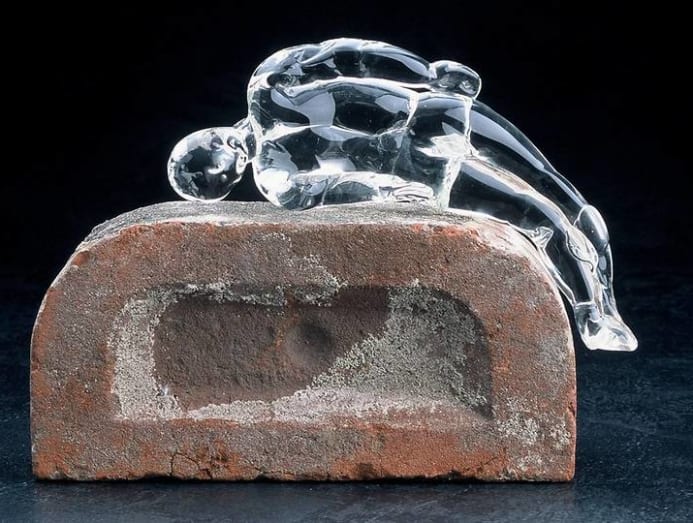
I Have TO Acknowledge, I KNOW LITTLE Nigh GLASS, OTHER THAN FROM WATCHING NETFLIX'S Blown Abroad AND GALLERY VISITS IN MURANO, Italian republic. TELL ME Almost THE Different KINDS OF Production.
Glass is one of the showtime "manmade" materials that has been used and fashioned in a plethora of means. It is difficult for me to describe the many kinds of glass-making production as there are so many. At that place are machine-made, mould-blown vessels (bottles and jars for packaging); float glass for windows and doors; borosilicate glass for science and heat-proof cookware; tempered glass for motorcar windscreens; and art glass created through hot glassworking, using kilns, glass casting, flameworking, coldworking and painting.
Art glass encompasses what y'all saw in Murano and in the Blown Away serial. It started in Murano in the 17th century when it was a trading port, a little like what Singapore is today. Fine art glass was an art form for Venetian merchants keen to brandish their wealth through ornate fine art glass – a most beautiful, expensive and difficult craft to principal. They also established a glassmaking heart on i of the Venetian islands.
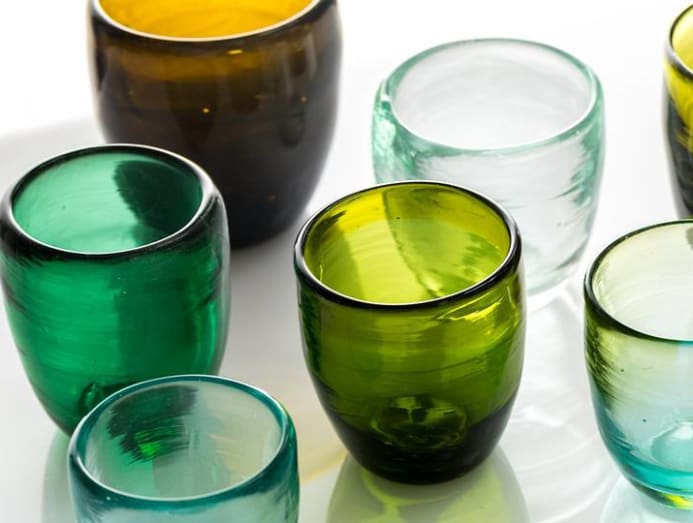
During the early 20th century, before the early 1960s, gimmicky glass was mass-manufactured in factories to create mainly functional containers. This form of glass art was pioneered in the early 1900s by Tiffany, Steuben, Galle, Hoya Crystal, Imperial Leerdam Crystal, Orrefors and Kosta Boda.
Creative drinking glass design emerged from the factories during the mid-1900s in Europe, where designers and artists were introduced to glassmakers. This combination of designer and maker led to the product of new products and artworks that had a marketing advantage over "cheap product" items.
READ: Creative Capital: This French-Javanese florist and vocaliser calls Singapore home
Studio drinking glass followed as a new use for glass. It became an artist's medium to produce artworks and sculptures. This is a relatively new phenomenon that emerged in the 1960s and 1970s. These days, art glassworks, fabricated in Murano and as seen on Diddled Away, are intended every bit artistic statements too as for sculptural and/or decorative purposes.
Studio drinking glass pieces tend to exemplify a artistic concept or as a prove of mastery of the difficult technical skills that crave time-consuming processes. The price of studio glass is, therefore, high. It can range from a few hundreds to hundreds of thousands of dollars – and even a few one thousand thousand dollars.
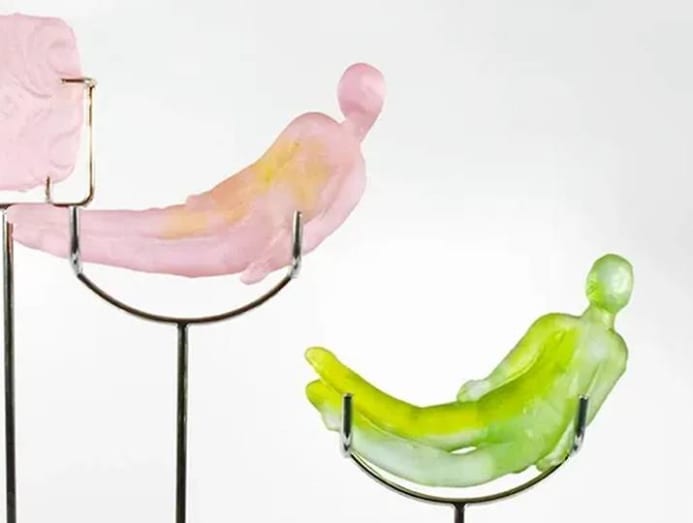
WHICH Way OF GLASSMAKING Practice YOU MOST Enjoy?
My showtime love is hot drinking glass. Picking up hot glass practice again for the 30-day challenge with Refind – a Singapore company that focuses on recycling drinking glass – has been a wonderful return to the physical, exhausting and embodied act of hot glassmaking.
Diddled Abroad SHOWED HOW DIFFICULT AND PHYSICALLY TAXING GLASSBLOWING IS. IS It Actually THAT TOUGH? AND ARE ACCIDENTAL BREAKAGES THAT COMMON?
Yeah, it is actually that tough, and aye, accidental breakages are really that common! Glassblowing is hot, very hot. You are standing in front of a reheating sleeping accommodation that is radiating estrus at 1,000 degrees Celsius. You sweat a lot, you need to drink a lot of water, eat a lot to maintain your energy and slumber a lot to rejuvenate your torso.
READ: Creative Capital letter: The 29-year-onetime multi-hyphenate who is a designer, entrepreneur and teacher
Accidents and breakages occur a lot when you are learning or trying something new. The timing is super critical. If one role of the piece is also cold and you accidently knock the piece, the whole thing will come unstuck and fall to the flooring.
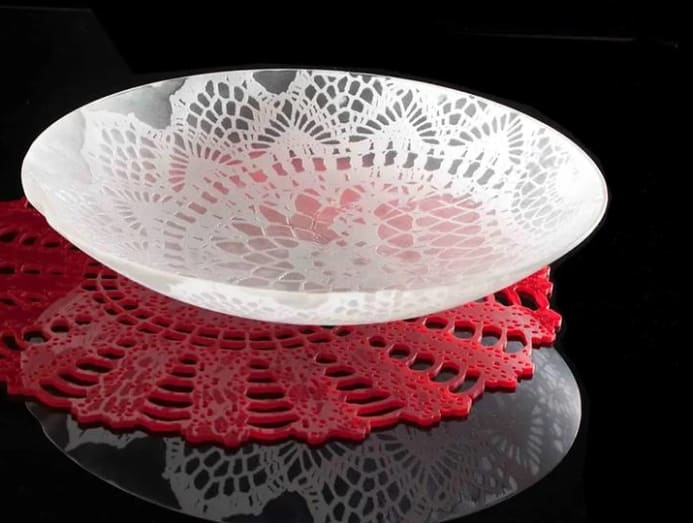
THROUGH YOUR Visitor, Art Glass SOLUTIONS, Y'all Accept PRODUCED SOME IMPRESSIVE Glass Fine art INSTALLATIONS. WHAT IS YOUR CREATIVE PROCESS WHEN A Client APPROACHES YOU WITH A Brief?
It starts with the gathering of information. Firstly, the basics – location, size, upkeep and timeline. Then, I develop some initial ideas or concepts suitable for the space and the activity that occurs within it. I besides practice considerable visual enquiry to notice out what is already in existence, so I may create something new, unexpected and dissimilar.
Once I have a scrap of an idea, I enquire more questions to ascertain harmony with the space: What is the purpose of the artwork? Who will be using the space? How will viewers first see the artwork and from what angle of approach? Then, I enquire questions about what the client does, what the people do in that space, what inspiration and/or conceptual ideas they prefer.
I normally offer up three different ideas and styles for the customer's feedback. One time the client shows preference for a certain management, I will develop it further with more visual inquiry and the ancestry of three-dimensional renderings to better illustrate and stand for my ideas. Once the concept and pattern are confirmed, I go from 2D designs to 3D maquettes and back again to bank check on the feasibly and aesthetics of the design inside the infinite.
READ: Creative Upper-case letter: The advertisement homo who inserts Singaporeans into classical paintings
Sampling is a critically important office of the creative procedure as I develop the first paper mock-ups to illustrate to the makers how the samples can be made and how they should expect. Samples ensure that what I take visualised is possible to fabricate. And as the samples get larger and more than sophisticated, nosotros become closer and closer to the final aesthetics of the artwork.
This design evolution process takes the longest every bit I develop new ways of working, challenging existing modes of production, and shifting the normal ways of doing things. A big office of my practice is to be very involved in the making process. Certainly, I have a vision but I as well like to exist involved in the making process, so equally to make unexpected decisions about colour and form while making.
In one case the client has signed off on the design and the samples are developed, production can begin. During this period, I get to, figurately speaking, "step into" the artwork. I am no longer looking at an epitome or a computer screen, only working inside the artwork, surrounded by structures and samples, and fully immersed in the process of making.
Even during this making process, I am repeatedly experimenting with different components, placements and making visuals of the completed artwork within the space to ensure everything volition materialise the fashion I have envisioned.
READ: Creative Capital: The Singapore brick artist who congenital a business organisation using Lego
Once all the components are complete, nosotros can begin the on-site installation. I take realised that we should always practise a pre-installation off-site to ensure it looks the style I expected it to look, and to avoid difficult and costly changes required on-site.
This as well lets the installers learn how to handle the glass, fix attachments and position the artwork. If at that place is no risk to practice an off-site installation, I usually install a sample piece – a life-size version in a different textile perhaps – to check position, size and layout.
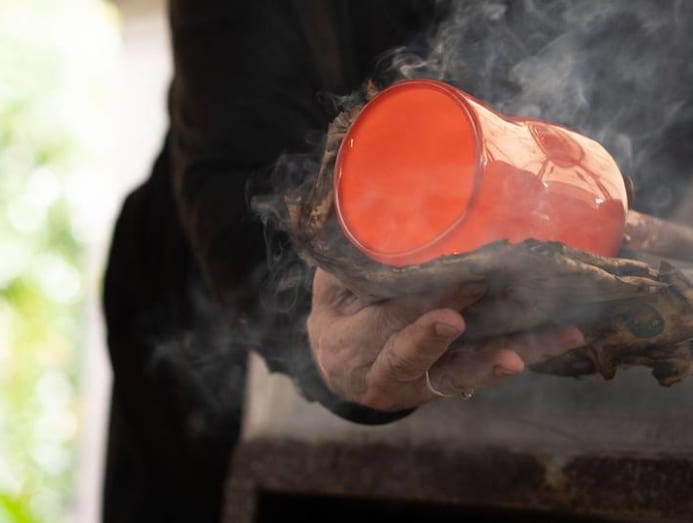
WHAT IS THE MOST CHALLENGING INSTALLATION YOU Take Washed?
The most challenging installation I have completed, and one of the largest to date, is Complex Simplicity at the Ocean Financial Centre in 2013. It was so big, it was necessary for me to design and develop a structure to support the wall, the sculptural wall finish and the 999 drinking glass fish.
It was of import that the artwork flowed every bit its focus was on the "movement" of the fish swimming. The verbal angle and distance from the wall for each fish were decided during installation, just the brackets that held each fish needed to exist confirmed before installation.
In add-on, I wanted the fish and brackets to be a seamless fit – and for the brackets to exist office of the pattern aesthetics. Furthermore, the brackets needed to exist piece of cake to remove for maintenance. That task alone took a year of design evolution, sampling, moulding and prototyping.
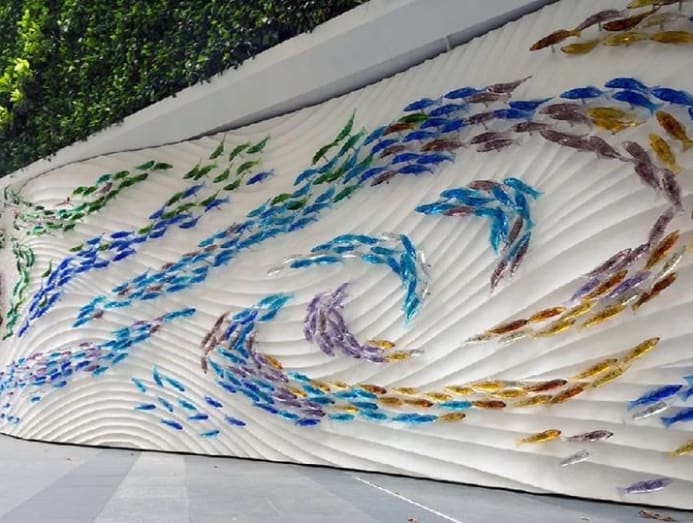
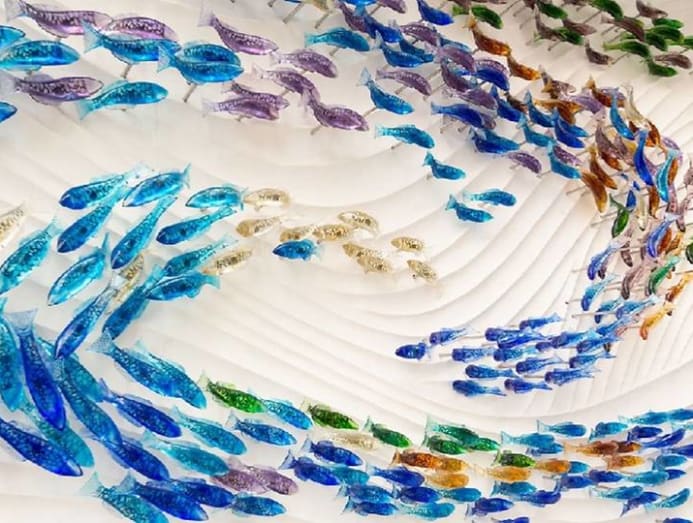
Some other year was spent developing the layout and installation planning, and yet another was spent on developing the fish shape, colour combinates and the subclass attachment details. Finally, shipping and installation took up the all-time part of vi months. The construction, sculptured wall bankroll, and finally, the fish, were installed layer by layer.
TELL ME ABOUT THE WORKSHOPS AND CLASSES Yous OFFER.
I am passionate well-nigh education glassblowing. I have been an educator since the late 1990s in Commonwealth of australia, Europe, the The states and now, Singapore. Sharing my love of this astonishing cloth is an important office of my practice equally an creative person and glassmaker.
READ: Creative Capital letter: The furniture man mixing augmented reality and old-schoolhouse craft in Singapore
I have been didactics beginner hot glass classes since I can recall. I beloved the procedure and I love teaching. Over the years, I have developed and refined the style I teach then students can learn a lot within a curt fourth dimension. Nonetheless, to empathise what they take learnt takes time and practice.
Teaching minor classes allows me to provide one-on-one instruction so beginners learn apace. The Blown Away show has increased involvement in glassmaking and many of my students have been excited to experience hot glassmaking for themselves.
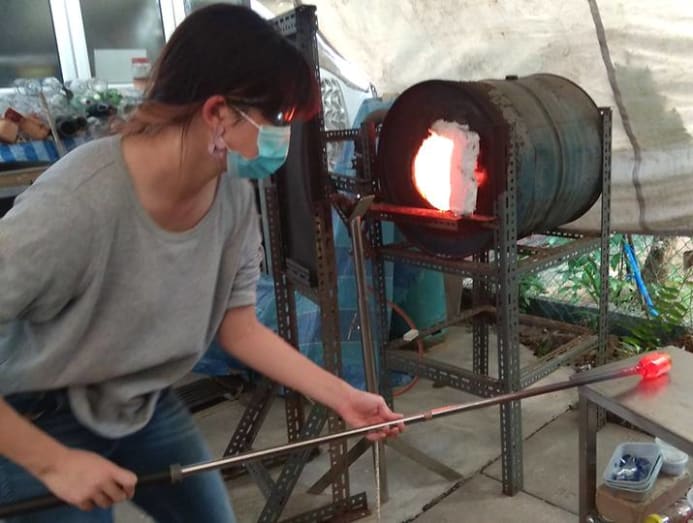
HOW DIFFICULT IS IT TO BE A Drinking glass ARTIST IN SINGAPORE?
Glassblowing is non like shooting fish in a barrel. It takes years to learn and even longer to master. I came to Singapore to teach but, unlike Commonwealth of australia, there was little interest in the applied arts then. The focus at the time was the development of the IT industry. Making, labouring, sweating and toiling are usually the occupations of others.
The fine art of hot glassmaking is far from an occupation that allows you to sit downwardly. It is far from clean and neat clothing, and a long way from air-conditioned condolement. And most students preferred to work at a computer in a comfortable chair, and under the cooling cakewalk of the air-conditioner.
Have THINGS Changed? ARE THERE ART SCHOOLS IN SINGAPORE Offer COURSES IN GLASSMAKING TODAY?
To my knowledge, in that location are no other formal educational facilities offering glassmaking courses in Singapore correct now. Lasalle, earlier moving its campus, began to refocus abroad from the applied arts, shifting Jewellery into Design, Ceramics into Sculpture, and closing down Drinking glass birthday.
The crafts and drinking glass departments in college educational institutions worldwide are closing, besides. Information technology is the trend every bit IT, spider web design, programming and computer designing courses get increasingly popular. New engineering science naturally offers more career options for graduates. Practical arts courses require extensive materials and equipment to run, thus, they are expensive, especially if in that location are only a few students interested to larn.
Over the past 15 years, I have continued to teach in studios and drinking glass schools in Europe and Commonwealth of australia. And as I see more academy courses close, I discover an increase in private studios opening up for classes and opportunities for hobbyists.
ARE Y'all MORE FOCUSED ON STUDIO Exercise AND TEACHING, OR DO You lot STILL Have ON COMMERCIAL PROJECTS?
Currently, my focus is on pedagogy and opening a new hot glass studio for the public in Singapore. Training others with a similar passion for fine art making and glassmaking is my current goal, so that others may take on the office of the teacher or trainer. Offering a diverse pick of courses that permit novices to larn new skills, and utilize a different side of their brains is the essence of my electric current focus on enrichment and experience.
Nevertheless, my passion remains for art drinking glass installation work. I design small-scale artworks for the habitation every bit well as seek out big-scale projects from developers and large corporations. Fine art making is something I will never stop doing, no affair how much teaching I practice. Art making is cardinal to who I am.
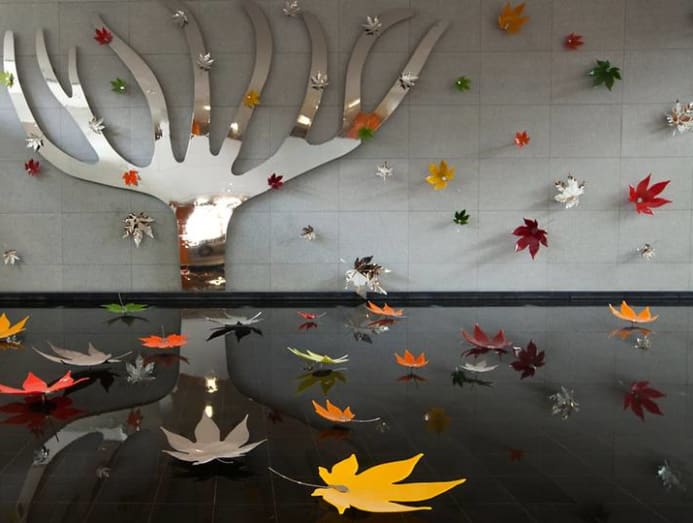
DID THE PANDEMIC DISRUPT YOUR PLANS FOR 2020? HOW WAS THE Yr FOR You lot?
I was in the procedure of attending a creative writing course in Tasmania when travel restrictions were enforced. Nosotros were forced to pivot and hold our sessions online.
I had also planned to travel to meet old friends and do a workshop or exhibition with them. Instead, I created a mini project called #getincontact, and connected with past colleagues and friends via Facebook, Zoom and Skype.
This creative project also provided me with a wonderful connection to an extended international customs of glass artists, one I did not previously make fourth dimension for. Also, I've decided to make my personal spaces public as no one can visit me in Singapore. I will be taking photos of my dwelling and work space, and posting these images online.
The biggest benefit of the excursion breaker menstruum was making the decision to take the time to extend myself with yoga classes every day, and undertake an online business organisation development course for a few weeks.
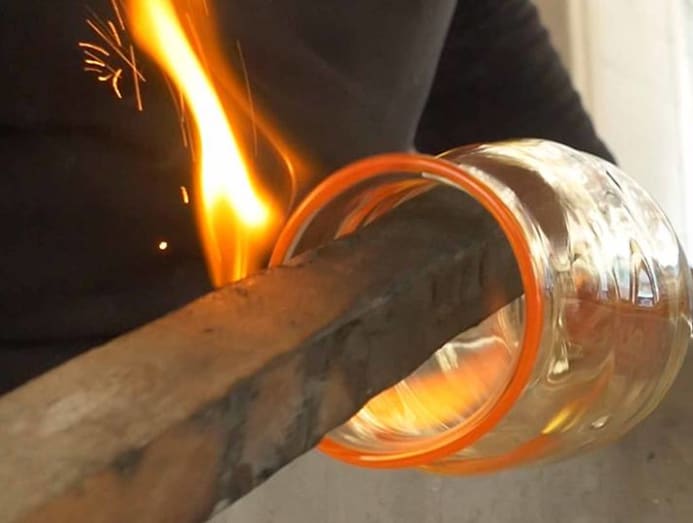
During i of these classes, the idea for Refind'south #30daychallenge emerged. And so, equally I conveniently take a home studio, I decided to accident glass with a unlike bottle drinking glass for iii hours every solar day for 30 days. This provided me with a cracking motivation to get up and work every day.
Posting the results online at #refindGS gave me the opportunity to think and write about the experiences of making. I too began to think more well-nigh what it is to recycle glass. How much glass is imported into Singapore every 24-hour interval, and how we might find new ways to use and re-use glass in innovative ways.
Whatsoever Heady PLANS FOR 2021?
The near exciting projection in 2022 is to build a hot glass school in Singapore, where teaching, learning and enrichment are the aim. As we look closer to abode during this new normal, offering the opportunity to learn something new such as hot glass is an interesting and exciting opportunity for many. The sense of wonder about this hot liquid material, doing a magical dance with information technology, and gaining the skills to create functional and decorative art out of glass are exciting.
Whether it be making a bracelet of beads, a tumbler to drink a favourite potable from, or a drinking glass dish to bring a little colour into the home, offering others the opportunity to work with glass is a big part of my next new adventure – and my ongoing journey and development as a glass creative person, educator and creator.
Editor'due south annotation: An earlier version of this story said Barbara Jane Cowie is Singapore'southward sole glass creative person, which is incorrect. We apologise for the error.
Recent Searches
Trending Topics
Source: https://cnalifestyle.channelnewsasia.com/entertainment/creative-capital-art-of-glassblowing-bj-cowie-glass-artist-237851

0 Response to "Creative Capital: Learn the art of glassblowing with this Singapore glass artist"
Post a Comment